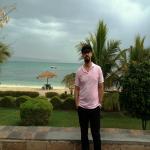The key question facing most sciences is "how" and thus focus on the process whereby something comes about regardless of time or place. Geography is described as a spatial science because it focuses is on "where" things are and why they occur there. Geographers seek to answer all or more than one of four basic questions when studying our environment. These relate to location, place, spatial pattern, and spatial interaction. Let's look at how a physical geographer answers these questions about a desert.
Figure 1.3 Location of the Sonoran Desert
Courtesy USGS (Source)
Location: Location is defined as "the position in space" of something. Latitude and longitude is a convenient way to locate something's position. The Sonoran Desert is located at a latitude and longitude of 33°40'N, 114°15'W. This defines the Sonoran Desert's absolute location. It actually covers an area of 311,000 square kilometers (120,000 sq mi) between 25° to 33° North and longitude 105° to 118° West. We can also define its where the Sonoran Desert in relation to a known location, called its relative location. "The Sonoran Desert wraps around the northern end of the Gulf of California, from northeastern Baja California through southeastern California and southwestern Arizona to western Sonora." (Wikipedia)
Place. Geographers describe place as “... the human and natural phenomena that give a location its unique character ...” (Gershmel, 2009). A geographer may want to know how the Sonoran Desert compares to the Sahara desert. To answer this question, a physical geographer will collect data to compare their temperatures and precipitation, and contrast the vegetation, soils and fauna found there.
Spatial Pattern. Geographers are especially interested in the arrangement or patterns of earth phenomena. We might want to know - "What is the distribution of deserts on the Earth?". By examining a map of world climates we find deserts in the dry interiors of the subtropics and midlatitudes.
Part 1 of 6
by
Arnold G. Fruchtenbaum
INTRODUCTION
The issue of Israel is one of the major points of division in evan-gelical theology today. This is true both among Arminians and
Calvinists. An evangelical theologian's view of Israel will determine
whether he is a Covenant Theologian or a Dispensationalist. It will also
determine what kind of Covenant Theologian he is: postmillennial,
amillennial, or premillennial.
The question of Israel is central for a proper Systematic Theol-ogy. Paul, in his epistle to the Romans, which contains the first
Systematic Theology in Church history, expounds on Israel in the cen-ter of his epistle devoting three full chapters (9-11) out of sixteen to
this topic. Yet, while there are many Systematic Theologies today that
have systematized all areas of biblical truth, none thus far has devel-oped an Israelology as part of their system. These articles will survey
what the concerns of an Israelology would be.
جهت دانلود مطلب کلیک فرمایید:
http://s5.picofile.com/file/8106183134/Israelogy.pdf.html
http://s5.picofile.com/file/8106183134/Israelogy.pdf.html
Acknowledgments
Iam especially indebted to Jochen Peters of the Center for Peace Studies at the
University of Tromsø for inviting me to serve as a juror at two Tromsø International
Film Festivals and to the jurors with whom I served (see Introduction). I want also
to thank those who invited presentations of prototypes of the various chapters,
commented on them, or inspired and supported aspects of my thinking and
analyses: Jane Bennett, Peter Burgess, Bill Connolly, Mick Dillon, Jason Frank,
Jon Goldberg-Hiller, Bianca Isaki, Sankaran Krishna, Debbie Lisle, Nizar Messari,
Daniel Bertrand Monk, Joao Nogueira, Rob Walker, Cindy Weber. I also owe
special thanks to the students in Rio who took my seminar on cinematic geopolitics
and edified me on the subject of Brazilian films: Daniel Mauricio Aragao, Moema
Viera Correa, Andrea Freitas da Conceicao, Carlos Frederico Pereira da Silva
Gama, Fabiano Mielniczuk, Marcello Mello Valenca, and Roberto Vilchez
Yamato. My greatest debt is to my wife and film-watching partner, Hannah
Tavares, whose compassion and critical thinking accompany me everywhere. This
book is dedicated to the memory of my late cousin, Malcolm Greenberg, who took
me to see one of my first war films, the Fred Zinnemann film version of James
Jones’s novel From Here to Eternity.Malcolm and his friend Alan provided the
first film commentary I had ever heard. Watching the film as a 13-year-old, I had
my attention on heroes and bad guys, and my primary emotion was fear, in reaction
to the brutality of Sgt. James R. (‘Fatso’) Judson (played convincingly by Ernest
Borgnine). As I regained my composure while Malcolm drove us home from the
film, I listened while he and Alan translated a war film drama into a complex story
about the ways in which characters are shaped by circumstances. Then, as always,
Malcolm displayed both a critical and a generous view of humanity’s diverse
personae. I profited from being exposed to both of his dispositions
جهت دانلود کامل کتاب کلیک کنید :
http://s5.picofile.com/file/8105996942/Cinematic_Geopolitics.pdf.html
سلام
گزیده سخنرانی مساله فلسفه و ماهیت در جغرافیا دکتر حافظ نیا و خانم دکتر میر حیدر جهت داتلود ارسال میگردد.
موضوعی مهمتر از فلسفه و ماهیت یک چیز نیست.......فلسفه سند آن چیز و بقای آن می باشد
لینک جهت دانلود چکیده مطالب :
سلام بر دوستان
نمونه سوالات زبان آزمون دکترا و هوش تحصیلی سال 90-91جهت دانلود
( زبان )
http://s5.picofile.com/file/8105905784/PHD_English.pdf.html
استعداد تحصیلی:
http://s5.picofile.com/file/8105905976/PHD_GMAT.pdf.html

 آمار
وب سایت:
آمار
وب سایت:
